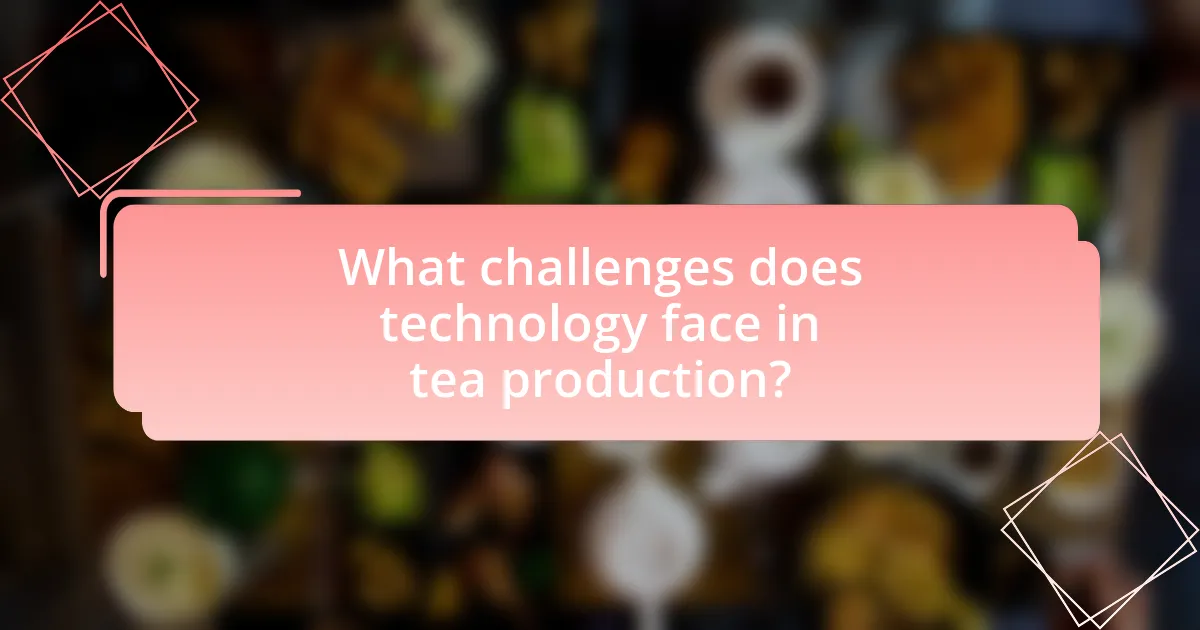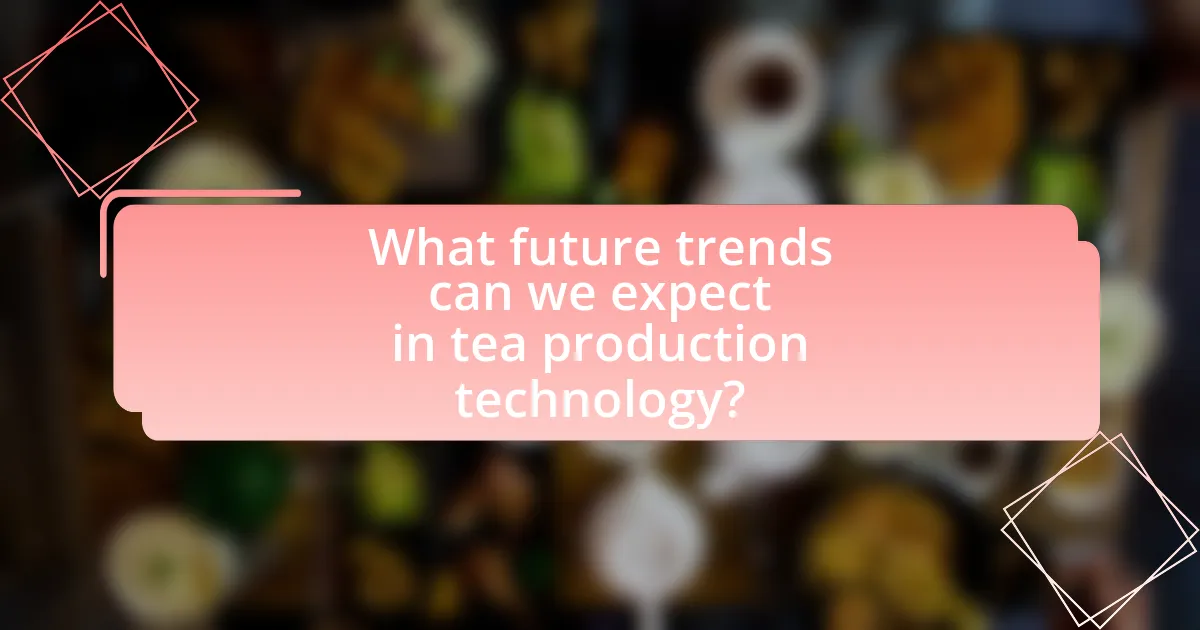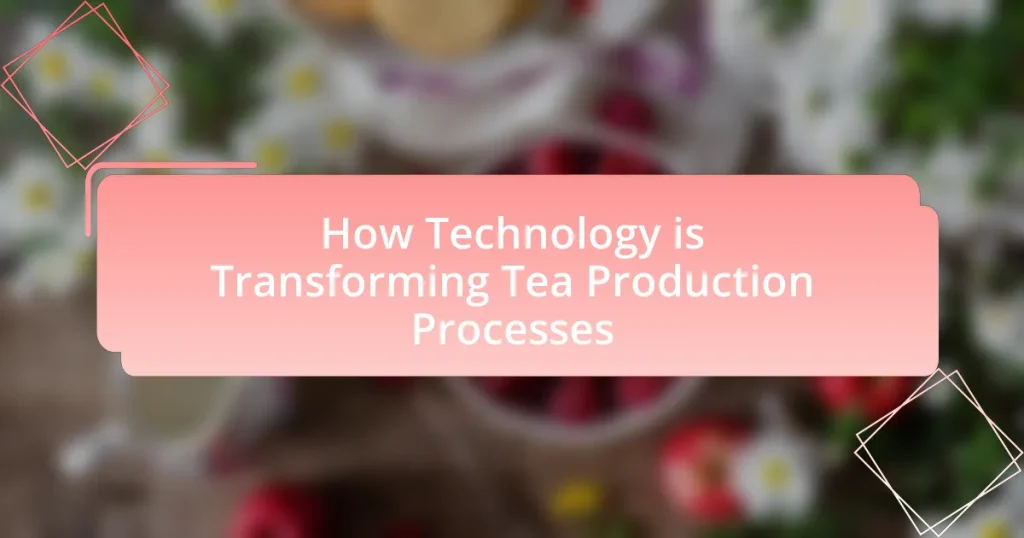The article examines how technology is transforming tea production processes, focusing on advancements such as precision agriculture, automated harvesting, and enhanced processing techniques. These innovations improve efficiency, quality, and sustainability in tea cultivation, with studies indicating potential increases in production efficiency by up to 30%. Key topics include the role of automated machines in harvesting, the impact of precision agriculture on resource management, and the influence of processing technologies on flavor profiles. Additionally, the article addresses environmental benefits, challenges in technology adoption, and future trends, including the integration of artificial intelligence and blockchain for supply chain transparency.

How is Technology Transforming Tea Production Processes?
Technology is transforming tea production processes by enhancing efficiency, quality, and sustainability. Innovations such as precision agriculture, which utilizes sensors and data analytics, allow farmers to monitor soil conditions and optimize irrigation, leading to improved crop yields. Additionally, automated harvesting machines reduce labor costs and minimize damage to the tea leaves, ensuring higher quality. Furthermore, advancements in processing technology, such as temperature-controlled drying and fermentation, enhance flavor profiles and preserve essential nutrients. According to a study by the Food and Agriculture Organization, the adoption of these technologies can increase tea production efficiency by up to 30%, demonstrating their significant impact on the industry.
What are the key technological advancements in tea production?
Key technological advancements in tea production include precision agriculture, automated harvesting, and advanced processing techniques. Precision agriculture utilizes data analytics and IoT sensors to monitor soil conditions and optimize irrigation, leading to improved crop yields. Automated harvesting employs robotics to efficiently pick tea leaves, reducing labor costs and increasing efficiency. Advanced processing techniques, such as machine-assisted withering and fermentation, enhance flavor consistency and reduce production time. These innovations collectively contribute to higher quality tea and more sustainable production practices.
How do automated harvesting machines impact tea production efficiency?
Automated harvesting machines significantly enhance tea production efficiency by increasing the speed and consistency of leaf collection. These machines can harvest tea leaves at a rate much faster than manual labor, often completing the task in a fraction of the time. For instance, studies have shown that automated harvesters can collect up to 90% of the leaves in a single pass, compared to manual picking, which is labor-intensive and time-consuming. Additionally, the precision of automated machines reduces leaf damage and ensures uniformity in the harvested product, leading to higher quality tea. This efficiency not only lowers labor costs but also allows for more frequent harvesting cycles, ultimately increasing overall yield per hectare.
What role does precision agriculture play in tea cultivation?
Precision agriculture significantly enhances tea cultivation by optimizing resource use and improving crop yields. This approach employs technologies such as GPS, sensors, and data analytics to monitor soil conditions, weather patterns, and plant health. For instance, precision irrigation systems can deliver water directly to the roots of tea plants, reducing water waste and ensuring optimal growth conditions. Research indicates that farms utilizing precision agriculture techniques can increase their yields by up to 20%, demonstrating the effectiveness of these methods in enhancing productivity and sustainability in tea production.
How does technology enhance the quality of tea?
Technology enhances the quality of tea by enabling precise control over cultivation, processing, and packaging. Advanced agricultural techniques, such as precision farming and automated irrigation systems, optimize growth conditions, resulting in healthier tea plants. For instance, sensors monitor soil moisture and nutrient levels, allowing for tailored fertilization and irrigation, which can increase yield and improve flavor profiles.
In processing, innovations like temperature-controlled drying and automated sorting systems ensure that tea leaves are processed at optimal conditions, preserving essential oils and flavors. Research indicates that maintaining specific temperature ranges during drying can enhance the aromatic compounds in tea, leading to a superior product.
Furthermore, technology in packaging, such as vacuum sealing and nitrogen flushing, protects tea from oxidation and moisture, extending shelf life and maintaining freshness. Studies show that properly packaged tea retains its quality for longer periods, ensuring consumers receive a high-quality product.
What technologies are used for monitoring tea plant health?
Technologies used for monitoring tea plant health include remote sensing, drones, soil moisture sensors, and machine learning algorithms. Remote sensing utilizes satellite imagery and aerial photography to assess plant health and detect stress factors such as pests or diseases. Drones equipped with multispectral cameras provide high-resolution images that help in identifying variations in plant health across tea fields. Soil moisture sensors measure the moisture levels in the soil, ensuring optimal irrigation practices. Machine learning algorithms analyze data collected from these technologies to predict plant health trends and optimize management practices. These technologies collectively enhance the efficiency and sustainability of tea production.
How do processing technologies affect flavor profiles in tea?
Processing technologies significantly influence flavor profiles in tea by altering chemical compounds during production. For instance, methods such as oxidation, steaming, and roasting can enhance or diminish specific flavor notes. Oxidation, used in black tea production, increases the complexity of flavors by developing polyphenols, which contribute to a richer taste. In contrast, steaming, common in green tea processing, preserves the fresh, grassy flavors by minimizing oxidation. Research indicates that the temperature and duration of roasting can also create distinct flavor profiles, as seen in oolong teas, where varying degrees of roasting lead to floral or toasty notes. These processing techniques directly impact the sensory attributes of tea, shaping consumer preferences and market trends.
What are the environmental impacts of technology in tea production?
The environmental impacts of technology in tea production include increased resource efficiency, reduced pesticide use, and enhanced sustainability practices. Precision agriculture technologies, such as drones and soil sensors, optimize water and fertilizer usage, leading to lower environmental degradation. For instance, a study published in the Journal of Cleaner Production found that the use of precision farming techniques can reduce water consumption by up to 30% in tea plantations. Additionally, integrated pest management systems, supported by technology, have been shown to decrease chemical pesticide application by 50%, minimizing harm to local ecosystems. Overall, technology in tea production promotes more sustainable practices that benefit both the environment and agricultural productivity.
How does technology contribute to sustainable tea farming practices?
Technology enhances sustainable tea farming practices by optimizing resource use and minimizing environmental impact. Precision agriculture technologies, such as soil sensors and drones, enable farmers to monitor soil health and crop conditions in real-time, leading to more efficient water and fertilizer application. For instance, a study by the International Tea Research Institute found that using soil moisture sensors can reduce water usage by up to 30%, promoting conservation. Additionally, data analytics and machine learning help farmers predict pest outbreaks and disease, allowing for targeted interventions that reduce the need for chemical pesticides. This integration of technology not only improves yield but also supports eco-friendly practices, aligning with global sustainability goals.
What are the implications of technology on water usage in tea production?
Technology significantly reduces water usage in tea production through precision irrigation systems and data analytics. These advancements enable farmers to monitor soil moisture levels and apply water only when necessary, leading to more efficient water management. For instance, drip irrigation systems can reduce water consumption by up to 50% compared to traditional methods, as they deliver water directly to the plant roots. Additionally, the use of sensors and satellite imagery allows for real-time data collection, helping producers optimize water usage based on climatic conditions and crop needs. This technological integration not only conserves water but also enhances crop yield and quality, demonstrating a clear link between technology and sustainable water practices in tea production.

What challenges does technology face in tea production?
Technology in tea production faces several challenges, including high initial costs, integration with traditional practices, and data management issues. High initial costs can deter small-scale farmers from adopting advanced technologies such as automated harvesting systems or precision agriculture tools, which can improve yield and quality. Integration with traditional practices poses a challenge as many tea producers are resistant to change, preferring established methods over new technological solutions. Additionally, data management issues arise from the need to collect, analyze, and utilize large amounts of data effectively, which can overwhelm producers lacking technical expertise. These challenges hinder the widespread adoption of technology in the tea industry, impacting overall productivity and sustainability.
What are the barriers to adopting new technologies in tea farming?
The barriers to adopting new technologies in tea farming include high initial costs, lack of technical knowledge, and limited access to financing. High initial costs deter farmers from investing in advanced equipment and systems, as many smallholder tea farmers operate on tight budgets. Additionally, a lack of technical knowledge prevents farmers from effectively utilizing new technologies, which can lead to underperformance and skepticism about their benefits. Limited access to financing options further exacerbates these issues, as many farmers struggle to secure loans or grants necessary for technology adoption. According to a study by the International Tea Committee, these barriers significantly hinder the modernization of tea production, impacting overall productivity and sustainability in the industry.
How does the cost of technology affect small-scale tea producers?
The cost of technology significantly impacts small-scale tea producers by influencing their production efficiency and market competitiveness. High technology costs can limit access to advanced tools and machinery, which are essential for improving yield and quality. For instance, a study by the International Tea Committee indicates that small producers who invest in mechanization can increase their output by up to 30%, but the initial investment can be prohibitive, often exceeding their annual revenue. Consequently, small-scale producers may struggle to compete with larger operations that can afford such investments, leading to reduced market share and profitability.
What skills are necessary for tea farmers to effectively use new technologies?
Tea farmers need technical skills, digital literacy, and data analysis capabilities to effectively use new technologies. Technical skills enable farmers to operate and maintain modern equipment, such as automated harvesting machines and irrigation systems. Digital literacy is essential for navigating software applications that assist in farm management, while data analysis skills allow farmers to interpret data from sensors and analytics tools to make informed decisions about crop management and yield optimization. These skills are increasingly important as technology continues to evolve in the agricultural sector, enhancing productivity and sustainability in tea production.
How can technology integration be improved in the tea industry?
Technology integration in the tea industry can be improved by adopting precision agriculture techniques, which utilize data analytics and IoT devices to optimize crop management. For instance, sensors can monitor soil moisture and nutrient levels, allowing farmers to apply water and fertilizers more efficiently, thereby increasing yield and reducing waste. A study by the International Tea Research Institute found that implementing such technologies can enhance productivity by up to 30%. Additionally, integrating blockchain technology can improve supply chain transparency, ensuring quality control and traceability from farm to consumer. This approach has been shown to increase consumer trust and market value, as evidenced by a report from the Food and Agriculture Organization, which highlights the growing demand for transparency in food sourcing.
What role do government policies play in promoting technological adoption?
Government policies play a crucial role in promoting technological adoption by providing frameworks that incentivize innovation and investment in new technologies. For instance, subsidies for research and development can lower the financial barriers for tea producers to adopt advanced agricultural technologies, such as precision farming tools. Additionally, regulations that support the integration of sustainable practices encourage the adoption of eco-friendly technologies, which can enhance productivity and reduce environmental impact. Evidence from countries like India shows that government initiatives, such as the Digital India program, have significantly increased the adoption of digital technologies in agriculture, leading to improved efficiency and yield in tea production.
How can collaboration between tech companies and tea producers enhance outcomes?
Collaboration between tech companies and tea producers can enhance outcomes by integrating advanced technologies such as data analytics, IoT, and AI into tea cultivation and production processes. This integration allows for precision agriculture, which optimizes resource use and increases yield; for instance, using IoT sensors can monitor soil moisture levels, leading to more efficient irrigation practices. Additionally, data analytics can provide insights into market trends and consumer preferences, enabling tea producers to tailor their products accordingly. A study by the International Tea Committee highlights that implementing technology in tea production can increase productivity by up to 30%, demonstrating the tangible benefits of such collaborations.

What future trends can we expect in tea production technology?
Future trends in tea production technology include the integration of automation, precision agriculture, and data analytics. Automation is expected to enhance efficiency in harvesting and processing, reducing labor costs and increasing productivity. Precision agriculture utilizes sensors and IoT devices to monitor soil conditions and plant health, allowing for optimized resource use and improved crop yields. Data analytics will enable producers to make informed decisions based on real-time data, enhancing quality control and supply chain management. These advancements are supported by the growing demand for sustainable practices and the need for higher quality tea, as evidenced by the increasing adoption of smart farming techniques in agricultural sectors globally.
How will artificial intelligence shape the future of tea production?
Artificial intelligence will significantly enhance tea production by optimizing agricultural practices, improving quality control, and streamlining supply chain management. AI technologies, such as machine learning and predictive analytics, can analyze vast amounts of data from soil conditions, weather patterns, and crop health to provide actionable insights for farmers. For instance, AI-driven systems can predict the best times for planting and harvesting, leading to increased yields and reduced waste. Additionally, AI can monitor tea quality through image recognition and sensory analysis, ensuring that only the best products reach consumers. According to a report by the Food and Agriculture Organization, the integration of AI in agriculture can increase productivity by up to 70%, demonstrating its potential impact on the tea industry.
What potential does blockchain technology have in tea supply chain transparency?
Blockchain technology has significant potential to enhance transparency in the tea supply chain by providing immutable records of transactions and traceability from farm to consumer. This technology allows stakeholders, including farmers, processors, and retailers, to access real-time data regarding the origin, quality, and journey of tea products. For instance, a study by the International Journal of Supply Chain Management highlights that blockchain can reduce fraud and ensure authenticity by enabling consumers to verify the source of their tea through a secure digital ledger. This level of transparency not only builds consumer trust but also promotes ethical sourcing practices within the industry.
How might advancements in biotechnology influence tea plant breeding?
Advancements in biotechnology can significantly enhance tea plant breeding by enabling precise genetic modifications and improving traits such as disease resistance, yield, and flavor. Techniques like CRISPR-Cas9 allow for targeted gene editing, which can accelerate the development of tea varieties that are more resilient to environmental stresses and pests. For instance, research has shown that genetically modified tea plants can exhibit increased resistance to pathogens, thereby reducing the need for chemical pesticides and promoting sustainable farming practices. Additionally, biotechnology can facilitate the identification of desirable traits through molecular markers, streamlining the breeding process and leading to faster development of high-quality tea cultivars.
What are the best practices for integrating technology in tea production?
The best practices for integrating technology in tea production include the use of precision agriculture, automation in processing, and data analytics for quality control. Precision agriculture utilizes sensors and drones to monitor soil health and crop conditions, leading to optimized irrigation and fertilization, which can increase yield by up to 20% according to a study by the Food and Agriculture Organization. Automation in processing, such as using robotic systems for plucking and sorting, enhances efficiency and reduces labor costs, with some farms reporting a 30% reduction in processing time. Data analytics enables producers to track and analyze production metrics, ensuring consistent quality and allowing for timely adjustments based on market demand. These practices collectively enhance productivity, sustainability, and profitability in tea production.
How can tea producers effectively evaluate and select new technologies?
Tea producers can effectively evaluate and select new technologies by conducting a thorough needs assessment, analyzing potential benefits, and considering cost-effectiveness. A needs assessment helps identify specific challenges in the production process that technology can address, such as improving yield or reducing labor costs. Analyzing potential benefits involves evaluating how the technology can enhance efficiency, quality, and sustainability in tea production. Cost-effectiveness analysis ensures that the investment aligns with the producer’s budget and expected return on investment. For instance, a study by the International Tea Committee highlights that producers who adopted precision agriculture technologies saw a 20% increase in yield while reducing water usage by 30%, demonstrating the tangible benefits of informed technology selection.
What strategies can be employed to ensure successful technology implementation?
Successful technology implementation in tea production can be ensured through comprehensive planning, stakeholder engagement, and continuous training. Comprehensive planning involves assessing the specific needs of the tea production process and aligning technology solutions accordingly. Stakeholder engagement ensures that all parties, including farmers, workers, and management, are involved in the decision-making process, which fosters acceptance and reduces resistance. Continuous training equips users with the necessary skills to effectively utilize new technologies, thereby enhancing productivity and efficiency. Research indicates that organizations that prioritize these strategies experience a 30% higher success rate in technology adoption compared to those that do not.


